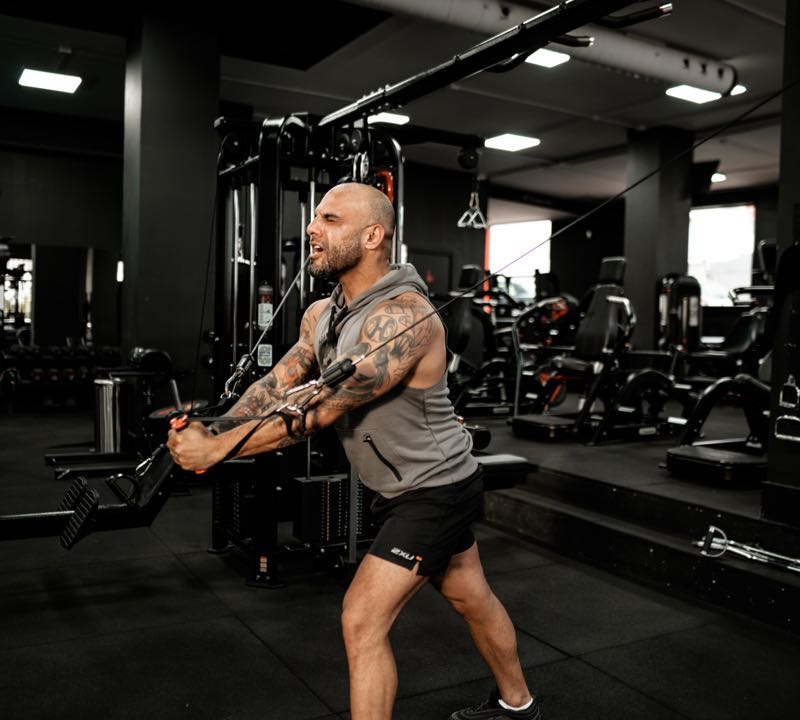You already know there are many great reasons to exercise—from improving energy, mood, sleep, and health to reducing anxiety, stress, and depression. And detailed exercise instructions and workout plans are just a click away. But if knowing how and why to exercise was enough, we’d all be in shape. Making exercise a habit takes more—you need the right mindset and a smart approach.
Whatever your age or fitness level—even if you’ve never exercised a day in your life —there are steps you can take to make exercise less intimidating and painful and more fun and instinctive.
Why a movement routine
Whatever your age or fitness level – even if you’ve never exercised a day in your life – there are steps you can take to make exercise less intimidating and painful and more fun and instinctive.
Research shows that self-compassion increases the likelihood that you’ll succeed in any given endeavor. So, don’t beat yourself up about your body, your current fitness level, or your supposed lack of willpower. All that will do is demotivate you. Instead, look at your past mistakes and unhealthy choices as opportunities to learn and grow.
Check your expectations
You didn’t get out of shape overnight, and you’re not going to instantly transform your body either. Expecting too much, too soon only leads to frustration. Try not to be discouraged by what you can’t accomplish or how far you have to go to reach your fitness goals. Instead of obsessing over results, focus on consistency.
While the improvements in mood and energy levels may happen quickly, the physical payoff will come in time. Going for a quick walk is better than sitting on the couch; one minute of activity will help you lose more weight than no activity at all.
That said, the current recommendations for most adults is to reach at least 150 minutes of moderate activity per week. You’ll get there by exercising for 30 minutes, 5 times a week. It’s okay to break things up. Two 15-minute workouts or three 10-minute workouts can be just as effective..
How to make exercise a habit that sticks
There’s a reason so many New Year’s resolutions to get in shape crash and burn before February rolls around. And it’s not that you simply don’t have what it takes. Science shows us that there’s a right way to build habits that last. Follow these steps to make exercise one of them.
If your workout is unpleasant or makes you feel clumsy or inept, you’re unlikely to stick with it. Don’t choose activities like running or lifting weights at the gym just because you think that’s what you should do. Instead, pick activities that fit your lifestyle, abilities, and taste.
People who exercise regularly tend to do so because of the rewards it brings to their lives, such as more energy, better sleep, and a greater sense of well-being. However, these tend to be long-term rewards. When you’re starting an exercise program, it’s important to give yourself immediate rewards when you successfully complete a workout or reach a new fitness goal.
Choose something you look forward to, but don’t allow yourself to do until after exercise. It can be something as simple as having a hot bath or a favorite cup of coffee.
“
No matter how much you enjoy an exercise routine, you may find that you eventually lose interest in it. That’s the time to shake things up and try something new or alter the way you pursue the exercises that have worked so far.
John Doe Tweet
Get inspired. Read a health and fitness magazine or visit an exercise website and get inspired with photos of people being active. Sometimes reading about and looking at images of people who are healthy and fit can motivate you to move your body.

Can you build muscle with smaller weights?
It can be hard to work out with so many distractions and difficulties keeping us from the gym. When we are able to work out, focusing on the exercise and blocking out distractions can be even harder. Too often, we power through a workout and check it off the list without thinking about how to improve mental health. So how do we bust through the distractions to get the most out of our workouts? Expert say without a mindful approach to a workout, we risk poor results or even injury. Mindfulness includes paying attention to how you’re breathing – and to an extent – even controlling it. Breathing exercises improve your mental health, too. Use these three easy-to-remember techniques to maximize your breathing before, during and after you exercise. Before: Set a Clear Intention Set an intention for your workout, given the time and space you have available. Example intentions could be to make sure you’re breathing during stressful moments or to savor your rest periods by being fully present in your breath. If you only have 30 minutes, position your workout accordingly and set the intention clearly. Revisit that intention regularly throughout your workout. Take a moment before you begin to check in with your body through breathwork. Focus on your inhale and see where the breath moves easily in your body. “Are you tensing in certain areas?” asks Tory. “Then you might be tight there. Pay attention to what your body is telling you and apply that to your workout.” If you want to improve mental health, it begins with paying attention. During: Use Your Breath as a Guide Be aware of your breath as you exercise. If your inhales and exhales shorten and quicken, that is a response to the work your body is doing. “If you’re bracing or holding your breath, you may be overexerting yourself,” says Tory. Using your breath correctly will reduce stress, help guide your workout and improve mental health. If you’re working out with a partner, you can use the you-go-I-go technique. “As your partner exercises, you can recover with intentional breathing, slowing down your heart rate. With partner exercises, synchronize your movements and your breaths,” Tory. “This will accentuate and strengthen the emotional connection between you.” After: Recover with Rhythmic Breathing Speed up recovery by incorporating breathing exercises with your stretching routine. “Focus on the areas that you stressed during the workout,” says Tory, “Breathe into the stretch and open up that tissue.” The goal is to get to a relaxed state, returning to rhythmic nasal breathing as soon as possible. By sealing your lips and focusing on breathing through your nostrils, your body will get the cue to relax through the rhythm of repetition. https://www.youtube.com/watch?v=TFO9hBtLVec&feature=emb_logo Consistency is more important than perfection. If you want to improve mental health, you don’t have to make drastic changes to your entire routine, just start incorporating mindfulness and breathwork into your existing routine. “ The smaller the change, the more sustainable it will be. Don’t tell yourself you will be mindful at every minute of your workout. You’re going to get distracted. Just keep coming back to your breath. John Doe Tweet Now that it’s in your toolkit, you can return to mindful breathing any time as another way build on your fitness, both physical and mental. So just breathe.

48 Days body transformation with Jorge
It can be hard to work out with so many distractions and difficulties keeping us from the gym. When we are able to work out, focusing on the exercise and blocking out distractions can be even harder. Too often, we power through a workout and check it off the list without thinking about how to improve mental health. So how do we bust through the distractions to get the most out of our workouts? Expert say without a mindful approach to a workout, we risk poor results or even injury. Mindfulness includes paying attention to how you’re breathing – and to an extent – even controlling it. Breathing exercises improve your mental health, too. Use these three easy-to-remember techniques to maximize your breathing before, during and after you exercise. Before: Set a Clear Intention Set an intention for your workout, given the time and space you have available. Example intentions could be to make sure you’re breathing during stressful moments or to savor your rest periods by being fully present in your breath. If you only have 30 minutes, position your workout accordingly and set the intention clearly. Revisit that intention regularly throughout your workout. Take a moment before you begin to check in with your body through breathwork. Focus on your inhale and see where the breath moves easily in your body. “Are you tensing in certain areas?” asks Tory. “Then you might be tight there. Pay attention to what your body is telling you and apply that to your workout.” If you want to improve mental health, it begins with paying attention. During: Use Your Breath as a Guide Be aware of your breath as you exercise. If your inhales and exhales shorten and quicken, that is a response to the work your body is doing. “If you’re bracing or holding your breath, you may be overexerting yourself,” says Tory. Using your breath correctly will reduce stress, help guide your workout and improve mental health. If you’re working out with a partner, you can use the you-go-I-go technique. “As your partner exercises, you can recover with intentional breathing, slowing down your heart rate. With partner exercises, synchronize your movements and your breaths,” Tory. “This will accentuate and strengthen the emotional connection between you.” After: Recover with Rhythmic Breathing Speed up recovery by incorporating breathing exercises with your stretching routine. “Focus on the areas that you stressed during the workout,” says Tory, “Breathe into the stretch and open up that tissue.” The goal is to get to a relaxed state, returning to rhythmic nasal breathing as soon as possible. By sealing your lips and focusing on breathing through your nostrils, your body will get the cue to relax through the rhythm of repetition. Consistency is more important than perfection. If you want to improve mental health, you don’t have to make drastic changes to your entire routine, just start incorporating mindfulness and breathwork into your existing routine. “ The smaller the change, the more sustainable it will be. Don’t tell yourself you will be mindful at every minute of your workout. You’re going to get distracted. Just keep coming back to your breath. John Doe Tweet Now that it’s in your toolkit, you can return to mindful breathing any time as another way build on your fitness, both physical and mental. So just breathe.

Why Breathwork Matters in Your Workout
It can be hard to work out with so many distractions and difficulties keeping us from the gym. When we are able to work out, focusing on the exercise and blocking out distractions can be even harder. Too often, we power through a workout and check it off the list without thinking about how to improve mental health. So how do we bust through the distractions to get the most out of our workouts? Expert say without a mindful approach to a workout, we risk poor results or even injury. Mindfulness includes paying attention to how you’re breathing – and to an extent – even controlling it. Breathing exercises improve your mental health, too. Use these three easy-to-remember techniques to maximize your breathing before, during and after you exercise. Before: Set a Clear Intention Set an intention for your workout, given the time and space you have available. Example intentions could be to make sure you’re breathing during stressful moments or to savor your rest periods by being fully present in your breath. If you only have 30 minutes, position your workout accordingly and set the intention clearly. Revisit that intention regularly throughout your workout. Take a moment before you begin to check in with your body through breathwork. Focus on your inhale and see where the breath moves easily in your body. “Are you tensing in certain areas?” asks Tory. “Then you might be tight there. Pay attention to what your body is telling you and apply that to your workout.” If you want to improve mental health, it begins with paying attention. During: Use Your Breath as a Guide Be aware of your breath as you exercise. If your inhales and exhales shorten and quicken, that is a response to the work your body is doing. “If you’re bracing or holding your breath, you may be overexerting yourself,” says Tory. Using your breath correctly will reduce stress, help guide your workout and improve mental health. If you’re working out with a partner, you can use the you-go-I-go technique. “As your partner exercises, you can recover with intentional breathing, slowing down your heart rate. With partner exercises, synchronize your movements and your breaths,” Tory. “This will accentuate and strengthen the emotional connection between you.” After: Recover with Rhythmic Breathing Speed up recovery by incorporating breathing exercises with your stretching routine. “Focus on the areas that you stressed during the workout,” says Tory, “Breathe into the stretch and open up that tissue.” The goal is to get to a relaxed state, returning to rhythmic nasal breathing as soon as possible. By sealing your lips and focusing on breathing through your nostrils, your body will get the cue to relax through the rhythm of repetition. https://www.youtube.com/watch?v=TFO9hBtLVec&feature=emb_logo Consistency is more important than perfection. If you want to improve mental health, you don’t have to make drastic changes to your entire routine, just start incorporating mindfulness and breathwork into your existing routine. “ The smaller the change, the more sustainable it will be. Don’t tell yourself you will be mindful at every minute of your workout. You’re going to get distracted. Just keep coming back to your breath. John Doe Tweet Now that it’s in your toolkit, you can return to mindful breathing any time as another way build on your fitness, both physical and mental. So just breathe.
follow
Error: No feed with the ID 2 found.
Please go to the Instagram Feed settings page to create a feed.

